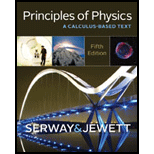
Concept explainers
(a)
The elapse in time interval
(a)
Answer to Problem 47P
The time interval elapses by
Explanation of Solution
Write the equation for the change in current in the circuit.
Here,
Write the equation for the time constant for the circuit.
Here,
Conclusion:
Substitute
Substitute
Therefore, the time interval elapses by
(b)
The current in the inductor
(b)
Answer to Problem 47P
The current in the inductor
Explanation of Solution
The change in current in the circuit is given in equation (I).
Here,
Conclusion:
Substitute
Therefore, the current in the inductor
(c)
The elapse in time before the current fall
(c)
Answer to Problem 47P
The time elapse before the current fall is
Explanation of Solution
Write the equation for the decay in the current.
Here,
Here,
Conclusion:
Substitute
Substitute
Therefore, the time elapse before the current in the inductor falls to
Want to see more full solutions like this?
Chapter 23 Solutions
Principles of Physics
- A generator connected to the wheel or hub of a bicycle can be used to power lights or small electronic devices. A typical bicycle generator supplies 6.00 V when the wheels rotate at = 20.0 rad/s. (a) If the generator's magnetic field has magnitude B = 0.600 T with N = 100 turns, find the loop area A. (b) Find the time interval between the maximum emf of +6.00 V and the minimum emf of 6.00 V.arrow_forwardThe time variation of the current in a 32.0-mH inductor is given by I = 9.00 + 3.00t − 3.00t2, with I in amperes and t in seconds. What is the magnitude of the emf induced in the inductor at the following? (a) t = 2.00 s V(b) t = 5.00 s V(c) For what value of t is the emf induced in the inductor 0? sarrow_forwardA 24-V battery is connected in series with a resistor and an inductor, with R = 3.8 Ω and L = 2.4 H, respectively. (a) Find the energy stored in the inductor when the current reaches its maximum value.______ J(b) Find the energy stored in the inductor one time constant after the switch is closed._______ Jarrow_forward
- A 24.0-V battery is connected in series with a resistor and an inductor, with R = 8.20 Ω and L = 2.00 H, respectively. (a) Find the energy stored in the inductor when the current reaches its maximum value in J. (b) Find the energy stored in the inductor at an instant that is a time interval of one time constant after the switch is closed in J.arrow_forwardThe energy stored in a solenoid inductor is 28.4 mJ. The solenoid has 425 turns, is .876 meters long and has a diameter of 37.2 cm. How much current is flowing through the solenoid inductor? A. 1.00 A B. 2.02 A C. 4.68 A D. .225 A E. 1.42 Aarrow_forwardA 5.00 [cm] long solenoidal inductor has 50 turns and radius of 3.00 [cm]. If the current varies at a rate of 8.30 [A/s], what is the magnitude of the induced EMF in the inductor ? A. Zero B. 1.78×10−7 [V] C. 2.94×10−5 [V] D. 1.47×10−3 [V]arrow_forward
 Physics for Scientists and Engineers, Technology ...PhysicsISBN:9781305116399Author:Raymond A. Serway, John W. JewettPublisher:Cengage Learning
Physics for Scientists and Engineers, Technology ...PhysicsISBN:9781305116399Author:Raymond A. Serway, John W. JewettPublisher:Cengage Learning Principles of Physics: A Calculus-Based TextPhysicsISBN:9781133104261Author:Raymond A. Serway, John W. JewettPublisher:Cengage Learning
Principles of Physics: A Calculus-Based TextPhysicsISBN:9781133104261Author:Raymond A. Serway, John W. JewettPublisher:Cengage Learning Physics for Scientists and Engineers: Foundations...PhysicsISBN:9781133939146Author:Katz, Debora M.Publisher:Cengage Learning
Physics for Scientists and Engineers: Foundations...PhysicsISBN:9781133939146Author:Katz, Debora M.Publisher:Cengage Learning Physics for Scientists and Engineers with Modern ...PhysicsISBN:9781337553292Author:Raymond A. Serway, John W. JewettPublisher:Cengage Learning
Physics for Scientists and Engineers with Modern ...PhysicsISBN:9781337553292Author:Raymond A. Serway, John W. JewettPublisher:Cengage Learning Physics for Scientists and EngineersPhysicsISBN:9781337553278Author:Raymond A. Serway, John W. JewettPublisher:Cengage Learning
Physics for Scientists and EngineersPhysicsISBN:9781337553278Author:Raymond A. Serway, John W. JewettPublisher:Cengage Learning College PhysicsPhysicsISBN:9781285737027Author:Raymond A. Serway, Chris VuillePublisher:Cengage Learning
College PhysicsPhysicsISBN:9781285737027Author:Raymond A. Serway, Chris VuillePublisher:Cengage Learning





